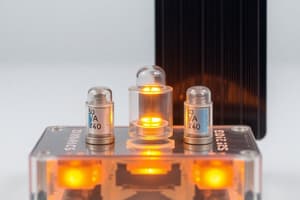Podcast
Questions and Answers
What is the primary function of the salt bridge in a voltaic cell?
What is the primary function of the salt bridge in a voltaic cell?
- To allow ions to flow between the half-cells (correct)
- To conduct electrons through the wire
- To produce copper ions from metallic copper
- To create oxidation reactions
Which statement accurately describes the process of oxidation in a voltaic cell?
Which statement accurately describes the process of oxidation in a voltaic cell?
- Zinc ions gain electrons and return to solid zinc
- Copper ions gain electrons and form copper metal
- Copper metal loses electrons and forms copper ions
- Zinc atoms lose electrons and become zinc ions (correct)
Which of the following components directly connects the two half-cells in a voltaic cell?
Which of the following components directly connects the two half-cells in a voltaic cell?
- Electrode
- Oxidizing agent
- Battery case
- Salt bridge (correct)
What happens to zinc metal in the voltaic cell as the reaction proceeds?
What happens to zinc metal in the voltaic cell as the reaction proceeds?
In the cell notation Zn(s) | Zn2+(aq) || Cu2+(aq) | Cu(s), what does '||' signify?
In the cell notation Zn(s) | Zn2+(aq) || Cu2+(aq) | Cu(s), what does '||' signify?
Which species acts as the reducing agent in the voltaic cell described?
Which species acts as the reducing agent in the voltaic cell described?
What is the result of the overall redox reaction in the voltaic cell?
What is the result of the overall redox reaction in the voltaic cell?
Which of the following correctly defines reduction in the context of the voltaic cell?
Which of the following correctly defines reduction in the context of the voltaic cell?
Flashcards
Voltaic cell
Voltaic cell
A chemical reaction that produces electric current.
Electron movement in voltaic cells
Electron movement in voltaic cells
The movement of electrons from a more reactive metal to a less reactive one.
Oxidation
Oxidation
The loss of electrons, often occurring at the anode in a voltaic cell.
Reduction
Reduction
Signup and view all the flashcards
Cell notation
Cell notation
Signup and view all the flashcards
Salt bridge
Salt bridge
Signup and view all the flashcards
Anode
Anode
Signup and view all the flashcards
Cathode
Cathode
Signup and view all the flashcards
Study Notes
Voltaic Cells
- Voltaic cells use a chemical reaction to produce electricity.
- Voltaic cells utilize oxidation-reduction reactions.
- A battery is a common example of a voltaic cell.
Basic Voltaic Cell Setup
- Two beakers, each containing a solution: one with zinc sulfate and the other with copper sulfate.
- A piece of zinc metal is placed in the zinc sulfate solution.
- A piece of copper metal is placed in the copper sulfate solution.
- A wire connects the zinc and copper metal, causing electrons to flow from zinc to copper.
- A salt bridge connects the two solutions.
Electron Movement
- Copper ions (Cu2+) have a stronger pull for electrons than zinc atoms.
- Zinc atoms lose electrons, becoming zinc ions (Zn2+) that dissolve in the solution.
- The lost electrons travel through the wire to the copper.
- Copper ions in the solution gain electrons, becoming neutral copper atoms that attach to the copper metal.
- This electron movement creates an electric current.
Oxidation and Reduction
- Oxidation: Loss of electrons, occurs at the anode (zinc metal).
- Reduction: Gain of electrons, occurs at the cathode (copper metal).
- Half Reactions:
- Oxidation: Zn(s) → Zn2+(aq) + 2e-
- Reduction: Cu2+(aq) + 2e- → Cu(s)
- Net Ionic Equation: Zn(s) + Cu2+(aq) → Zn2+(aq) + Cu(s)
Cell Notation
- A shorthand representation of the voltaic cell:
- Zn(s) | Zn2+(aq) || Cu2+(aq) | Cu(s)
Salt Bridge
- A tube filled with an electrolyte (e.g., sodium chloride) connecting the two solutions.
- Prevents a buildup of charge in each half-cell by allowing ions to flow between the solutions.
- Positive ions from the salt bridge move toward the negative side to balance charge.
- Negative ions from the salt bridge move toward the positive side to balance charge.
Overall Changes in the Voltaic Cell
- The zinc metal dissolves as atoms lose electrons and become ions in the solution.
- The copper metal increases in size as copper ions gain electrons and become neutral atoms that attach to the metal.
- The flow of electrons through the wire constitutes the electric current generated by the voltaic cell.
Studying That Suits You
Use AI to generate personalized quizzes and flashcards to suit your learning preferences.




